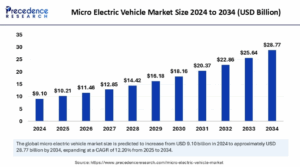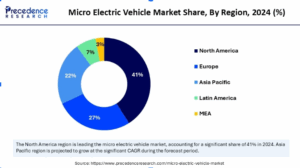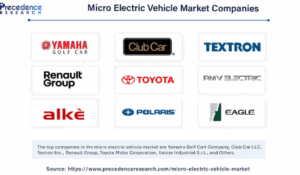The global micro electric vehicle (EV) market is gaining significant momentum, thanks to the growing demand for sustainable urban mobility solutions. Valued at USD 9.10 billion in 2024, the market is projected to reach approximately USD 28.77 billion by 2034, growing at a robust CAGR of 12.20% from 2025 to 2034. The North American market alone accounted for USD 3.73 billion in 2024 and is on track to expand at a slightly higher CAGR of 12.33% during the forecast period.

This surge is closely tied to the rise in urban mobility trends, where cities are shifting focus toward eco-friendly transport and compact electric vehicles to combat congestion, reduce emissions, and enhance accessibility. Micro EVs, including quadricycles, golf carts, and other light electric vehicles, are becoming the go-to option for urban dwellers and last-mile delivery services alike.
What’s Powering the Micro EV Boom Around the World?
- Sustainable Transportation Mandate: Governments and municipalities are investing heavily in low-emission transportation as part of climate action plans. Micro EVs serve as a perfect fit for short-distance commutes and environmentally friendly transport zones.
- Last-Mile Delivery Revolution: With the e-commerce boom, last-mile delivery has become a critical component of urban logistics. Companies are now opting for compact EVs to reduce operational costs, navigate narrow streets, and comply with zero-emission delivery zones.
- Government Incentives: Nations across the globe are introducing tax credits, rebates, and policy support to encourage EV adoption. For instance, the U.S. offers federal tax credits under the Clean Vehicle Credit program, while European countries like France and Germany provide direct subsidies on small electric vehicles.
- Congestion and Parking Woes: In dense urban environments, where traffic jams and parking shortages are a daily struggle, the compact size and maneuverability of micro EVs make them a practical alternative.
How Cutting-Edge Tech Is Shaping the Next-Gen Micro EVs
- EV Battery Innovation: Improvements in lithium-ion battery efficiency are enabling longer travel ranges, faster charging times, and reduced vehicle weight, critical for micro EVs.
- Smart Mobility Solutions: Integration of IoT and AI technologies has brought connected micro vehicles into the mainstream. Features like GPS navigation, remote diagnostics, and app-based vehicle access are enhancing user convenience.
- Lightweight Design and Modular Engineering: Advances in materials science allow for safer, more durable yet ultra-light designs that optimize battery usage and performance.
- Autonomous Features: While still in its infancy, autonomous driving capabilities are being explored for use in controlled environments like campuses, airports, and resorts.
Micro Electric Vehicle Market Trends
Battery Technology & Infrastructure
- Dominance of Lithium-Ion Batteries: In 2023, lithium-ion batteries accounted for over $4.5 billion in the micro-EV market, favored for their higher energy density and longer lifespan.
- Advancements in Battery Swapping: Companies like SUN Mobility in India have established over 600 battery swapping stations, enhancing convenience for micro-EV users.
- Expansion of Charging Infrastructure: The proliferation of EV charging stations is crucial for micro-EVs, which are designed for short-distance urban commutes and rely heavily on the availability of convenient charging points.
Regional Developments
- Asia-Pacific Growth: China’s micro-EV market is expanding rapidly, with models like the Wuling Hongguang Mini EV selling over 261,000 units in 2024.
- North American Market: In 2024, North America held a 41% share of the global micro-EV market, valued at $3.73 billion.
- Indian Initiatives: Uttar Pradesh leads India’s EV market, accounting for over 14% of the nation’s EV sales in 2023, with significant investments in charging infrastructure and manufacturing
Technological Innovations
- Smart Connectivity Features: Automotive companies are focusing on developing micro-EVs with features such as smart parking assistance and integration with smart city infrastructure.
- Vehicle-to-Grid (V2G) Technology: Emerging opportunities lie in integrating V2G technology, allowing micro-EVs to contribute to grid stability and potentially generate revenue for owners.
- Swappable Battery Systems: The development of swappable battery systems addresses range anxiety and charging time concerns, potentially accelerating adoption in urban areas
Where Are Micro EVs Thriving, and Why?”
North America led the global market in 2024 with a commanding 41% market share, largely driven by high adoption in gated communities, golf resorts, and retirement villages. Infrastructure support and favorable policies further fuel this dominance.

Meanwhile, Asia Pacific is emerging as the fastest-growing market from 2025 to 2034. Factors such as rapid urbanization, dense population, and government EV mandates (like India’s FAME II and China’s New Energy Vehicle program) are accelerating demand. The Asia EV market is also characterized by local manufacturing ecosystems and cost-effective models tailored for diverse demographics.
Europe, with its focus on emission-free zones and urban sustainability, remains a strong contender in both innovation and adoption.
Micro Electric Vehicle Market Segments
Quadricycles and Golf Carts: Compact Mobility in Different Settings
Micro electric vehicles are categorized by type, primarily into quadricycles and golf carts, each serving distinct mobility needs. Quadricycles are small, four-wheeled electric vehicles ideal for urban environments, offering efficient, short-range travel for both personal and commercial purposes. Their compact size and maneuverability make them perfect for city streets and narrow lanes. A prime example is the Renault Twizy, which is designed for dense urban traffic and limited parking spaces. On the other hand, golf carts are extensively used in controlled-access areas such as resorts, airports, golf courses, and gated communities. These light electric vehicles facilitate quiet, eco-friendly movement across campuses and leisure destinations, where low-speed travel is both sufficient and desirable.
Battery Choices: Balancing Cost with Performance
Battery technology plays a vital role in the performance and appeal of micro EVs. The market typically sees two main types: lead acid and lithium-ion batteries. Lead acid batteries, though affordable and readily available, are heavier and have a shorter lifespan, making them more suitable for basic models or applications with limited range needs. In contrast, lithium-ion batteries are rapidly becoming the standard due to their high energy efficiency, lighter weight, faster charging capabilities, and longer operational life. These attributes make lithium-ion batteries ideal for the demanding needs of urban micro mobility, where efficiency and frequent use are priorities.
Diverse Applications: From Deliveries to Public Service
The application landscape for micro EVs is broad and evolving. In commercial use, these vehicles are increasingly adopted for last-mile delivery, security patrols, and maintenance services, especially in urban zones where conventional vehicles face restrictions. For personal use, micro EVs offer a convenient solution for daily short-distance travel, particularly among city dwellers and the elderly seeking low-speed, easy-to-operate vehicles. Meanwhile, public utilities are deploying micro EVs for a variety of functions, including park management, street maintenance, and internal transport for municipal workers. These practical, environmentally friendly vehicles align well with public sector sustainability goals and operational efficiency.
What Roadblocks Do Micro EVs Face, And Where’s the Untapped Potential
- Range Limitations: Most micro EVs are designed for short distances, which may limit adoption in regions lacking charging infrastructure.
- Safety Concerns: Due to their smaller build and lower speed limits, these vehicles may be more vulnerable in mixed traffic environments.
- Regulatory Inconsistencies: Differing rules across regions — especially on classification and road eligibility — create hurdles for standardization and cross-border market expansion.
Yet, the landscape is rich with opportunity:
- Fleet Electrification: Municipalities, universities, and corporate campuses are turning to micro EV fleets for internal transportation and logistics.
- Mobility for the Aging Population: With their easy access, lower speeds, and affordability, micro EVs are ideal for senior citizens, enhancing mobility without compromising safety.
- Urban Infrastructure Integration: Cities are increasingly integrating dedicated EV lanes, parking zones, and smart charging stations to support micro mobility.

Which Companies Are Leading the Micro EV Revolution?
- Yamaha Golf Cart Company
- Club Car LLC
- Textron Inc.
- Renault Group
- Toyota Motor Corporation
- Italcar Industrial S.r.l.
- PMV Electric Pvt. Ltd.
- Alke
- Polaris
- Suzhou Eagle Electric Vehicle Manufacturing Co., Ltd








Discussion about this post